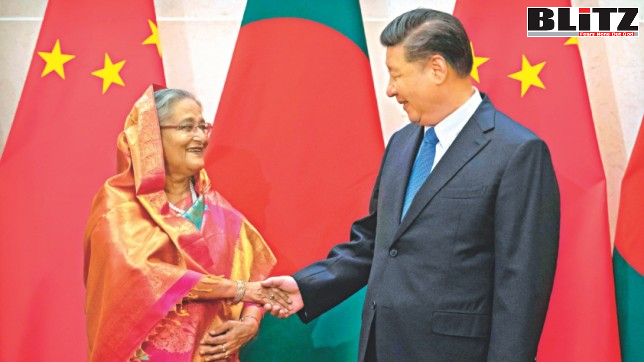Bangladesh, China and BRI

Image collected
People are there to criticize Bangladesh’s joining Chinese President Xi Jinping’s magnificent project – Belt and Road Initiative (BRI). India is desperately trying to stop or discourage Bangladesh from remaining in BRI, stating, it is a “debt trap”. But of course, Bangladeshi Prime Minister Sheikh Hasina does not listen to any undue advice from any country. She knows best – what is good for her country and her people. This is for the first time; Bangladesh has already emerged into a nation that has learnt to ignore any undue pressure or suggestions from any of its friends in the world.
During Sheikh Hasina’s recent China visit, several instruments were signed, which included five agreements, three memorandums of understating and a document – covering a range of sectors including power, investment, culture, tourism, and technology. Important among these is a Letter of Exchange under which China will provide Bangladesh with 2,500 metric tons of rice as an aid for the Rohingya refugees and two agreements that relate to China’s extension of loans worth US$ 1.7 billion for Bangladesh’s power sector. Although the amount of rice donated by China for the Rohingya refugees is just a fraction of the total requirement, still it showed the gesture of friendship and cordiality of China towards Bangladesh. It is well expected that in the future, China will play an important role in putting pressure of Myanmar in immediately resolving the longstanding Rohingya crisis and take their citizen back from Bangladesh.
During Bangladeshi Prime Minister’s visit, Beijing also assured Dhaka that it would better align its projects under the Belt and Road Initiative (BRI) with Bangladesh’s development priorities.
Bangladesh being an important member of the BRI since 2016 has received significant amounts of funding from China for infrastructural development projects. The two friendly countries signed 27 agreements for investments and loans worth around US$ 24 billion during Chinese President Xi Jinping’s visit to Dhaka in 2018. Together with the US$ 13.6 billion invested in joint ventures earlier, Chinese investment in Bangladesh is currently estimated at over US$ 38 billion, making China as Bangladesh’s single largest investor. This also makes Bangladesh the second-largest recipient of Chinese loans under BRI in South Asia.
Of course, India, being the key rival of China has been desperately trying to stop Bangladesh from continuing its growing relations with China. Pro-Indian think tanks and media outlets in Bangladesh are spreading rumors and lies centering BRI thus projecting this excellent initiative as a “trap” of China.
If we closely look into Bangladesh-China relations, it will be proved, Beijing has always been extremely sincere in maintaining a relationship with Dhaka, based on mutual respect and trust. Furthermore, China has never been hostile towards Bangladesh. There is growing relations between the two countries in the defense sector as well. But, some of the Indian think tanks and columnists are spreading lies with the ulterior motives of sabotaging the ever-growing Sino-Bangladesh relations. India wants to establish a monopoly in supplying defense hardware to Bangladesh as well as create the atmosphere of inter-military cooperation, despite the fact, Indian defense hardware is rather backward in comparing to the same from China. Moreover, India itself greatly depends on importing defense hardware from countries like Russia, the United States, and Israel.
On the other hand, China not only is supporting Bangladesh in the defense sector, it also is Bangladesh’s largest trade partner and trade is growing rapidly. Two-way trade, which was worth $12 billion in 2014, is expected to exceed $30 billion by 2021. While trade is booming, there is a strong imbalance in favor of China.
As mentioned above, Chinese investment in Bangladesh has been growing remarkably in recent years. Between 1977 and 2010, Beijing’s investment in Bangladesh totaled just $250 million. This rose to roughly $200 million in 2011 alone. In the wake of the BRI, China has emerged Bangladesh’s largest investor.
Like other emerging economies, Bangladesh is anxious to develop its infrastructure. However traditional sources of funding have proved inadequate, driving Dhaka to look to the BRI and China to meet this need.
China is playing an important role in Bangladesh’s infrastructure development. It has upgraded Chittagong port and is building an industrial park there. It is also constructing road and railway lines linking this Bay of Bengal port to Kunming in China’s Yunnan province. China has also built eight friendship bridges in Bangladesh, including the $3.7 billion road and rail bridge across the Padma River. Additionally, China is investing in a $1 billion project to improve digital connectivity. And China is investing heavily in Bangladesh’s power sector. Indeed, most of its investment in the 2018-19 fiscal year went into Bangladesh’s energy sector, particularly to coal-fired power plants, including those being constructed at Chittagong and Payra.
For Bangladesh, joining BRI is being a huge benefit and once the project is implemented, Bangladesh’s economy will witness tremendous boom, with neighboring India’s economy struggling badly. We need to remember; Bangladesh currently is one of the fastest growing economies in the world. According to analysts, within next twenty years, our economic growth will cross most of the nations in the region, while millions of unemployed and struggling population in the West Bengal and northeastern part of India may at one stage revolt against their central policymakers for miserably failing in addressing issues such as unemployment.
Priyanka Choudhury is the Assistant Editor of Blitz.
Source: https://www.weeklyblitz.net